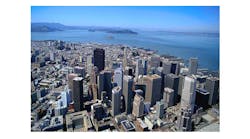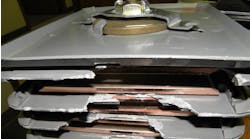San Francisco Publishes Energy Consumption Data for More Than 300 City Buildings
The San Francisco Public Utilities Commission (SFPUC) unveiled detailed energy usage information for more than 300 municipal buildings in a report released recently to demonstrate how the city’s new building energy benchmarking ordinance can help both public and private property owners find ways to save energy and money and better understand how buildings use energy.
“Just as owners of commercial buildings must take inventory of their energy use, the city is making sure we lead by example and provide transparency and accountability about our own operations, an essential component of San Francisco’s goal to reduce carbon emissions,” said Mayor Edwin M. Lee. “I’m proud of the progress we have made and will continue to capitalize on the opportunities ahead that will save energy and taxpayer dollars.”
The report details the energy use of 305 city facilities, including libraries, medical clinics, police stations and more during 2011. Altogether, these buildings comprise 37 million square feet of floor space.
“As they say, you can’t manage what you don’t measure," said SFPUC General Manager Harlan L. Kelly Jr. "While the city is doing quite well overall, we are always looking for ways to be more efficient. San Francisco’s public buildings also have the additional environmental benefit of receiving their clean, greenhouse-gas-free electricity from the Hetch Hetchy Power system.”
“Tracking energy usage through benchmarking reveals which facilities are performing well, and helps agencies understand which should be prioritized for improvements.” said John Updike, director of real estate for the city and county of San Francisco.
This benchmarking effort is part of the SFPUC’s larger energy-efficiency and green building program. In fact, the SFPUC has completed more than 150 energy efficiency projects in municipal buildings, which are saving the city approximately $4.6M each year.
Key benchmarking findings include:
-
In 2011, the 305 buildings analyzed used just under 3.5 million MMBtu of energy (electricity, natural gas and steam combined) and were responsible for 91,454 tons of CO2 equivalent emissions.
-
The overall energy usage of buildings in 2011 declined 3.8% from 2010 and 1.1% from 2009. This translates into approximately $1 million less in energy costs in 2011 than the previous year.
-
As expected, some building types are bigger energy users per square foot than others, for example hospitals and museums (higher energy intensity) vs. fire stations and libraries (lower energy intensity).
- Of the 30 buildings that were eligible for energy ratings from the EPA, 75% performed equal to or better than the national average for similar buildings; and 11 of those buildings performed in the top 25% nationwide – the threshold for the ENERGY STAR label. These top performing buildings include the Public Defender’s Office, Mission Mental Health Services, and Chinatown Child Development Center. The ENERGY STAR label has not yet created ratings categories for most other public building types.
“We are learning what some private property owners who are already benchmarking buildings have known for some time — that regular measurement of building energy performance helps identify opportunities to save energy, lower operating expenses and improve property values. We hope that other owners will see the benefits for themselves as they evaluate their buildings’ energy use under the city’s benchmarking ordinance,” said Melanie Nutter, director of the San Francisco Department of Environment.
Passed in Jan 2011, the Existing Commercial Building Energy Performance Ordinance requires owners of commercial buildings 10,000 square feet or larger to annually measure the energy performance of their buildings — a process known as benchmarking — and report energy use information to the city. It also requires owners to conduct energy audits of buildings every five years. Owners of buildings 25,000 sq. ft. and larger are already benchmarking energy use and filing reports with the city; while owners of buildings between 10,000-25,000 sq. ft. will begin benchmarking in 2013.
San Francisco’s ordinance is unique among many green-building initiatives in that it provides owners with actual energy performance information on their buildings year-to-year, not modeled or hypothetical scenarios. It also provides a national energy score so owners can see if their buildings are over or under-performing compared to similar buildings. Audits then give owners specific direction as to which building energy systems need improving, if any, and clear analysis of the costs and benefits of making those improvements.
San Francisco is one of six cities and two states with building energy benchmarking ordinances, including Seattle, New York City, Austin, Washington, D.C., Philadelphia, California, and Washington. San Francisco is the first city on the West Coast to release municipal building energy use information following New York and Washington D.C., last year.
The San Francisco Public Utilities Commission offers an array of energy efficiency, green building, and clean energy programs to its customers. For more information, visit www.sfwater.org.



